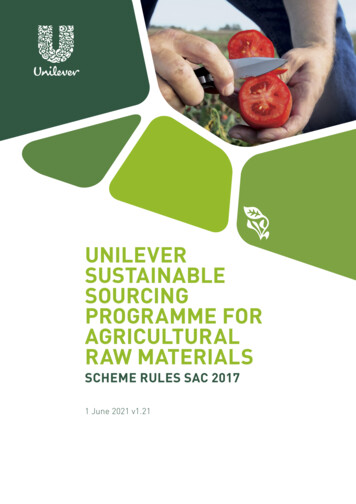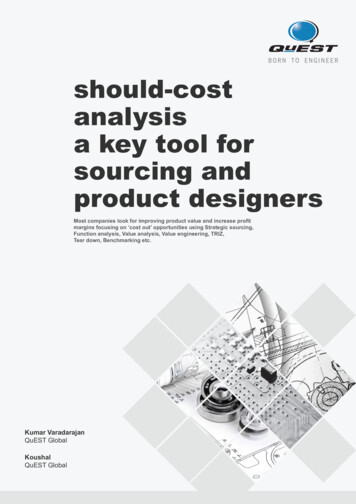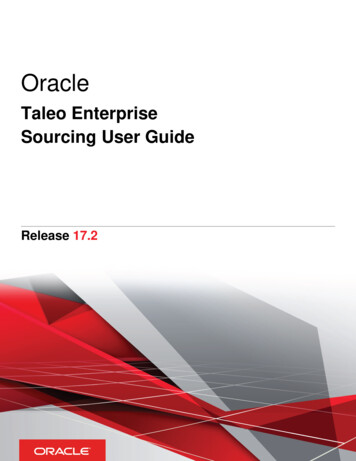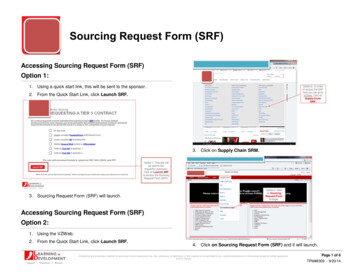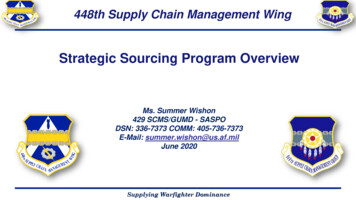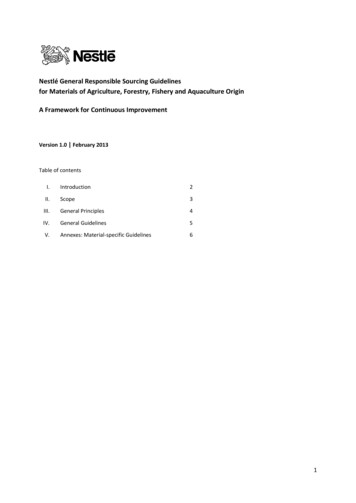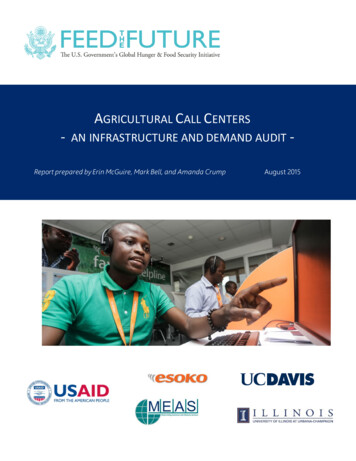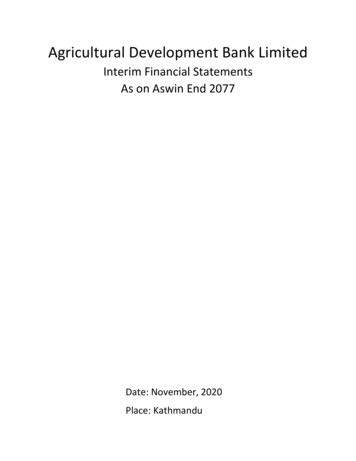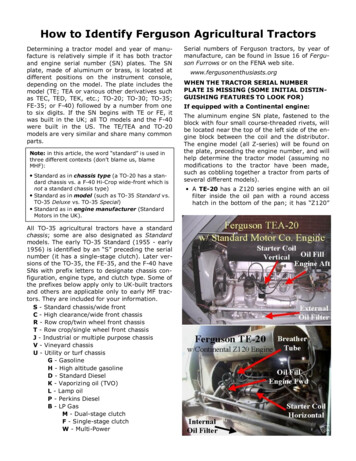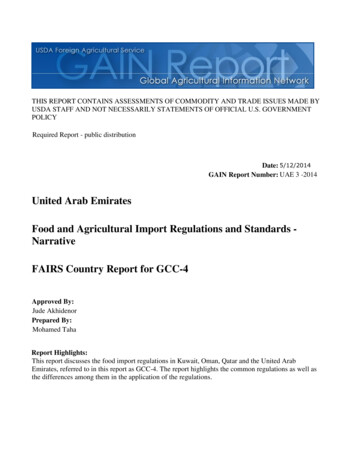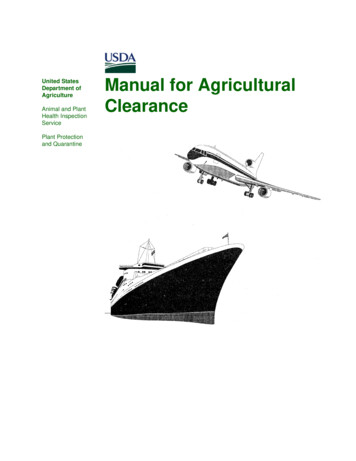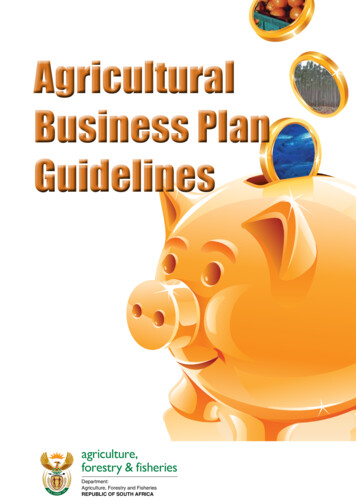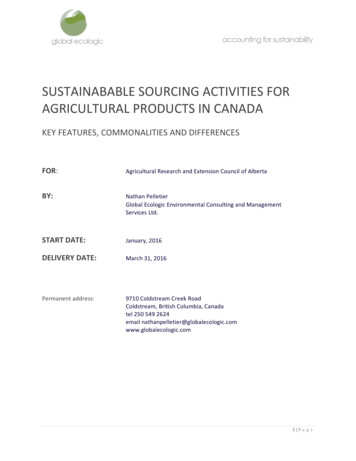
Transcription
SUSTAINABABLE SOURCING ACTIVITIES FORAGRICULTURAL PRODUCTS IN CANADAKEY FEATURES, COMMONALITIES AND DIFFERENCESFOR:Agricultural Research and Extension Council of AlbertaBY:Nathan PelletierGlobal Ecologic Environmental Consulting and ManagementServices Ltd.START DATE:January, 2016DELIVERY DATE:March 31, 2016Permanent address:9710 Coldstream Creek RoadColdstream, British Columbia, Canadatel 250 549 2624email ic.com1 P a g e
Liability StatementThis report was developed based on information and methods considered to be credible. Users of thedata and information contained herein are solely responsible. Global Ecologic Ltd. is not liable for anyloss or damage arising from use of the information contained in this report.Funding and DisclaimerThe report was prepared as information for the Agricultural Research and Extension Council of Alberta(ARECA). The views and opinions expressed in this report are not necessarily those of ARECA.Suggested Citation FormatPelletier, Nathan. 2016. Sustainable Sourcing Programs in Canada. Produced for the AgriculturalResearch and Extension Council of Alberta by Global Ecologic Environmental Consulting andManagement Services, Canada.About Nathan Pelletier and Global EcologicNathan Pelletier (Global Ecologic Environmental Consulting and Management Services) works closelywith clients to build an understanding of supply chain environmental and social sustainabilityperformance and mitigation opportunities. These include application of environmental and social lifecycle assessment, environmental footprinting, supply-chain greenhouse gas accounting and othermodeling approaches, as well as the social license/market access dimensions of sustainabilitymanagement. He is dedicated to delivering high-quality, cost-effective consulting services to meet thedemands of citizens, firms and organizations committed to furthering sustainability objectives. For moreinformation, see Appendix B.2 P a g e
Executive SummaryThe marketplace for agricultural products is increasingly influenced by activities aimed at measuring andcommunicating information with respect to the sustainability implications of both specific food productsand production practices. These initiatives generally consider the entire value chain but focus, inparticular, on the farm-level production of agricultural commodities, where the majority of resource useand potential impacts tend to be concentrated. Initiatives which fall under the broad category of“responsible” or “sustainable” sourcing have proliferated in recent years.In Canada, several industry-led, multi-stakeholder initiatives to define the criteria, indicators andprotocols to support sustainable sourcing for particular commodity groups are currently underdevelopment. In addition to these, numerous companies host their own, in-house sustainable sourcingprograms, and a variety of international initiatives which could potentially be applied to sustainablesourcing in Canada also exist.This study undertook to screen sustainable sourcing initiatives for their potential applicability for Albertafarmers (current or future) in order to identify and evaluate a subset of the most relevant among theseschemes. This subset was subjected to more detailed analysis in order to characterize key features,commonalities and differences among the schemes.The screening exercise and subsequent analysis provided strong indication that the scale of actualimplementation of sustainable sourcing activities that are of relevance for major agriculturalcommodities in Alberta is currently very limited. With few exceptions, discussions with representativesof industry associations, companies, and other stakeholders suggested that very few farmers arepresently being asked by value chain partners to participate in and demonstrate compliance with therequirements of sustainable sourcing activities. Notable exceptions include potato growers participatingin the Potato Sustainability Initiative, canola growers participating in ADM’s Sustainable GrowersProgram, and livestock operators subject to animal welfare audits by processors, food service providers,retailers and/or restaurants. The current lack of implementation of sustainable sourcing activitiesspecific to the environmental performance of most major Alberta agricultural commodities likelyreflects, in part, the tactical approach of many businesses, who tend to focus their immediate efforts onmore controversial products such as seafood, palm oil, and Brazilian soy, or on issues raised by theircustomers such as animal welfare and anti-biotic use.One notable challenge for the implementation of sustainable sourcing requirements in Canada is thatmost bulk commodities are commingled and marketed as “Canadian.” Traceability to specific farms oreven provinces is very difficult in these circumstances. The use of mass balance approaches byprocessors, who operate at an important nexus point between producers and their downstreamcustomers and who are hence well-positioned to mediate the sustainable sourcing requirements of3 P a g e
different customers, provides one option for communicating the degree of implementation of requiredpractices along the supply chain. The challenge of incentivizing producers and discouraging free-riding,however, remains.Beyond general principles regarding promoting more sustainable agricultural practices, the evaluatedschemes were found to be quite heterogeneous in both breadth and depth. Some of the more matureschemes – for example, Unilever’s Sustainable Agriculture Code and the International Sustainability andCarbon Certification system – provide detailed requirements and supporting guidance. Many of theinitiatives, however, only describe general objectives and requirements. In the case of the latterschemes, implementation at the farm level will likely be challenging.The most prevalent type of sustainable sourcing scheme is the “compliance checklist” approach,whereby farmers are required to demonstrate compliance with a set of required outcomes or bestpractices. Prescriptive, quantitative performance targets are not commonly employed, although someschemes do ask for goal setting with respect to reducing, for example, greenhouse gas emissions, waste,and water use. Other kinds of schemes such as calculators and certification programs do exist but areless common. Third-party tools such as calculators developed through multi-stakeholder initiatives may,however, be used by some companies in support of specific sustainable sourcing activities. For example,General Mills is currently using the Canadian Fieldprint Calculator for pilot projects in Manitoba andSaskatchewan. One common thread tying most the schemes together is the emphasis on demonstrationof continuous improvement over time.A large number of different criteria and indicators for various aspects of environmental sustainability areemployed by the schemes considered. Animal welfare and socio-economic criteria are also common,although these were not the subject of detailed analysis in this study. There is, however, a smallersubset of criteria that is common across most of the schemes. These are: Water Management; EnergyUse/Efficiency; Climate; Soil Management; Biodiversity Conservation/Enhancement; WasteManagement; Crop Protection Management; and Nutrient Management. At the more specific level ofindicators used to assess performance for these criteria, the sets employed by each scheme typicallyvary. Also variable is the degree of specificity and guidance to support demonstrating compliance withthe criteria and indicators. Moreover, some schemes refer to criteria only, without describing supportingindicators.Requirements and practice related to verification/audit also differ considerably. A small number ofschemes provide a detailed description of verification/audit requirements. Others state simply thatsuppliers must demonstrate compliance with their requirements, including for the upstream supplychain, and that audit/verification may be undertaken. For some schemes, no information referring toverification/audit activities was identified.Taken together, these observations suggest considerable scope for maturation for most of the initiativesevaluated, as well as the clear desirability of harmonization among initiatives. In general, the feasibility4 P a g e
and efficacy of sustainable sourcing will be strongly influenced by the extent to which farmers areenabled to participate. This requires clarity and consistency in requirements, verification/auditmechanisms, and avoidance of duplication and overburden resulting from farmers having to grapplewith multiple, heterogeneous schemes.5 P a g e
ContentsExecutive Summary . 3List of Figures . 8List of Tables . 9Introduction . 10Methods . 12Identifying Applicable Sustainable Sourcing Schemes . 12Characterizing Commonalities and Difference between the Selected Sustainable Sourcing Schemes . 14Characterization by type . 14Characterization of criteria and indicators employed . 14Characterization of verification/audit requirements . 14Summary of commonalities and differences. 14Evaluation of the accessibility of the selected sustainable sourcing schemes . 15Results and Discussion . 18Summary of the Sustainable Sourcing Schemes Considered . 20Multi-Stakeholder Initiatives . 21Private Company Initiatives. 37Characterization of Commonalities and Differences between the Selected Sustainable SourcingSchemes . 61Characterization by Scheme Type . 61Criteria and Indicators Employed by the Sustainable Sourcing Schemes. 62Audit/Verification Requirements of the Sustainable Sourcing Schemes . 67Assessment results for the “accessibility” of the selected sustainable sourcing schemes . 70Summary of Some Key Commonalities and Differences among the Selected Schemes . 71Conclusions . 76Appendix A. Detailed Evaluation Results for the Accessibility of the Program/Activity . 78Canadian Fieldprint Calculator . 78Sustainable Agriculture Initiative Farm Sustainability Assessment 2.0 . 79ISCC/ISCC Plus . 806 P a g e
Potato Sustainability Initiative . 81Nestle Supplier Code and Responsible Sourcing Guideline . 82Unilever Sustainable Agriculture Code . 83Molson Coors Supplier Code and Agricultural Brewing Ingredients Policy . 84Kelloggs Supplier Code . 85Sysco Supplier Code and Related Measures . 86Walmart Sustainability Index and The Sustainability Consortium . 87Pepsico Supplier Code and Sustainable Farming Initiative. 88Appendix B. About Nathan Pelletier and Global Ecologic . 907 P a g e
List of FiguresFigure 1. "Accessibility" scores (ranked from highest to lowest) for a subset of each of the reviewedsustainable sourcing schemes. . 718 P a g e
List of TablesTable 1. Matrix of criteria applied for evaluating the selected sustainable sourcing schemes foraccessibility. . 16Table 2. Sustainability schemes selected for detailed assessment. . 20Table 3. Characterization of schemes by type. 62Table 4. Criteria employed by the selected schemes. . 65Table 5. Characterization of scheme audit/verification requirements. . 68Table 6. Summary of key commonalities and differences among the selected schemes. . 74Table 7. Sustainable sourcing programs that refer to priority Alberta commodities. 769 P a g e
IntroductionSustainability, and sustainable food systems in particular, are topics of increasing importance in societyat large. This growing attention to the role of food production as a key contributor to sustainabilityoutcomes reflects the very large contribution made by food systems in aggregate to our collectiveresource demands, as well as a host of both environmental impacts and socio-economic costs andbenefits that accrue across ecosystems and stakeholder groups. Understanding, measuring, andmanaging the sustainability of particular food products and production technologies is therefore an areaof intense research and implementation activities.Of central importance to the field of food system sustainability measurement and management is lifecycle thinking – which is, perhaps, the most importance new paradigm in the art and practice ofeffective management. Life cycle thinking requires that managers seek to understand and influenceactivities and interactions across the entire value chain in order to promote improved sustainabilityoutcomes. Importantly, this approach to sustainability management facilitates identification of potentialtrade-offs that may occur as a result of management decisions – whether at different stages along thevalue chain or between various sustainability objectives. Essential to effective life cycle-basedsustainability management is engagement and collaboration with value chain partners, whosecooperation is essential in leveraging improvements.Beginning in the early 2000’s large food companies such as Unilever and Danone began to convenemulti-stakeholder groups in order to develop schemes to support sustainable sourcing by processors,food service providers, restaurants, and other customers of food products. These initiatives reflected agrowing recognition among leading companies of increasing societal expectations regarding corporatesocial responsibility as well as the competitive advantage that would ultimately be conferred to those atthe leading edge of sustainability management. Since the majority of emerging research suggested thatthe largest share of supply chain sustainability impacts for food products tended to be concentrated atthe level of raw material production, such schemes encompassed the entire supply chain.The momentum behind sustainable sourcing activities and programs in the food system was furtherbolstered by strong signals from European regulators regarding the eventual legislation of corporatesocial responsibility. Indeed, a variety of initiatives have been undertaken or supported by the EuropeanCommission with respect to developing standards to enable a level playing field in food systemsustainability initiatives associated with policy developments. These initiatives have underscored thatsustainability as the bottom line of business activity has now become a “when” rather than “if”question.Since these first developments with respect to sustainable sourcing activities in the food supply chain,similar efforts by both multi-stakeholder groups and individual companies have proliferated. At present,food system stakeholders, including farmers, face a bewildering array of actual or emerging10 P a g e
expectations and requirements for participation in food supply chain sustainability programs. Theseprograms, which may include environmental, animal welfare, and socio-economic sustainability criteria,are highly diverse. The sheer number of such programs, as well as considerable inconsistency betweenthem with respect to requirements, indicators, and rigor is clearly inefficient both for farmers and othervalue chain actors. As a result, harmonization efforts to bring greater consistency and rigor to suchefforts have also become quite important. Harmonization efforts are largely being led by industryassociations in the food system, in cooperation with a variety of stakeholders including farmers. Animportant feature of any such initiative is, wherever possible, to build on existing programs and systemsthat are already in place, and which are familiar to stakeholders.The Environmental Farm Plan (EFP) program is a whole-farm, self-assessment tool that enables farmersto identity environmental risks associations with their activities, and to develop risk reduction plans. EFPhas been operational in Canada since its genesis in Ontario in 1993. All provinces along with the YukonTerritory have since implemented their respective versions of the EFP program. At present, roughly 35%of producers accounting for 50% of the agricultural land base in Canada have completed an EFP.Although EFP programs differ by province in certain respects, there is nonetheless considerablesimilarity between them. A national-level initiative is currently underway to explore opportunities forharmonization. One key purpose of a harmonized, national EFP is to ensure that provincial/territorialEFPs cover, to the extent possible, the common requirements of various sustainable sourcing programs.Towards this end, the Agricultural Research and Extension Council of Alberta (ARECA), which managesthe Alberta EFP program, has begun to explore the possible role of a modified EFP program in enablingfarmers with an EFP to satisfy the environmental component of current or emerging sustainablesourcing programs. As part of this process, ARECA commissioned Global Ecologic Ltd. to undertake astudy of sustainable sourcing programs in Canada which may prove relevant for Alberta farmers.Specifically, the study is to evaluate key commonalities and differences between the most relevant ofsuch programs. An envisioned second step of this research is to evaluate the extent to which the EFPcurrently enables farmers to satisfy the common requirements of these programs, as well as whatmodifications to the program might be entertained such that the majority share of requirements can besatisfied. The current report describes the rationale, methods and results of the initial phase of thisresearch.11 P a g e
MethodsIdentifying Applicable Sustainable Sourcing SchemesThere is a wide variety of programs and activities that are designed for, or may be applied in the contextof, sustainable sourcing of agricultural products. These programs may address single or multipledimensions of sustainability (i.e. environmental, social, economic, animal welfare, food quality andsafety, etc.). They may be multi-stakeholder initiatives, industry programs, private company, orgovernment-sponsored activities. They may also be applicable in specific geographies or globally, and forspecific food products or for agricultural raw materials in general.Several reports are available describing and evaluating various among these schemes. These include, forexample:oSustainability indicators, tools and reporting systems for agri-food products. Prepared byGlobal Ecologic Environmental Consulting and Management Services Ltd. for AlbertaAgriculture and Rural Development. 2015.oSustainability evaluation techniques. Prepared for Environmental Stewardship Division,Alberta Agriculture and Rural Development by Campbell H and K Koehler-Munroe. 2013.oExamination of government & non-governmental sustainability requirements foragriculture products. Prepared for Agriculture and Agri-Food Canada by WaterfallAdvisors Group Ltd. 2012oEvaluation of Agri-food Sustainability Certification Systems. Prepared by George MorrisCentre for Ontario Fruit and Vegetable Growers Association.Internet searches or perusal of materials available in academic databases further reveal a diversity ofadditional initiatives.A first necessary step for this study was to identify which among these schemes may be mostrelevant/applicable for Canadian farmers in general, and for Alberta farmers more specifically. Followingan initial scan of the above resources in order to identify sustainable sourcing schemes of potentialrelevance, the following criteria were applied in order to arrive at a short-list of schemes to beconsidered: the scheme refers specifically or generally to a priority Alberta agricultural commodity, asdetermined based ono agricultural area devoted to production of the commodity in Alberta (including, forlivestock, feed input production), specifically12 P a g e
§§§§§§§o wheatcanolatame haybarleypeasoatslivestock (beef, pork, chicken, eggs, milk)a specific request by ARECA that the commodity be considered in the study§ sugar beets§ potatoesapparent relevance of the scheme, as indicated by telephone and email correspondence withrepresentatives of industry associations in order to determine the perceived relevance ofparticular schemes for each commodity groupapparent relevance of the scheme as indicated by telephone and email correspondence withscheme owners in order to determine the perceived importance of the scheme for Canadianfarmers in general and for Alberta farmers in particularapparent scale of implementation of the scheme, as indicated by publically available reportsregarding instances of scheme implementationin the case of private company schemes, both size and Canadian presence of the companyin the case of private company schemes, indication by a company representative (in telephoneor email correspondence) or in publically available literature published by the company that thescheme is being or may be implemented in Canada generally or in Alberta specificallyquantity and quality of publicly available information describing the schemeEfforts were also made to select a cross-section of schemes representing the activities of different foodsystem actors, including processors, retailers, food service providers, and industry groups. In somecases, this meant the inclusion of schemes for which limited information was available, or with limitedcurrent attention to Alberta-relevant commodities.Once a short-list of schemes to be considered was identified, a summary description of eachprogram/activity was developed based on publically available information and additional informationobtained via telephone and/or email correspondence with scheme owners or stakeholders.13 P a g e
Characterizing Commonalities and Difference between the Selected SustainableSourcing SchemesCharacterization by typeIn order to facilitate evaluation of the selected sustainable sourcing schemes, they were firstcharacterized by type. The classifications employed were: Calculators (on-line or downloadable tools whose primary purpose is to allow directcalculation of the sustainability performance of agri-food production or products)Certification programs (requiring third-party verification of sustainability performanceagainst a publically available standard)Checklist compliance programs (sustainable sourcing programs that apply checklistswith respect to a subset of sustainability indicators or best practices and require eitherself or third-party assessment)OtherCharacterization of criteria and indicators employedThe specific criteria and indicators employed for each program were identified. Where criteria andindicators referring to a common theme were identified, they were assigned under a common heading(for example, indicators related to crop protection product application, handling, management, etc.were assigned under the criteria “crop protection management ” (specific details regarding criteria andindicators are provided in the summary description for each sustainable sourcing scheme). Frequency ofuse of each criterion was also assessed in order to determine the apparent comparative relevance ofeach.Characterization of verification/audit requirementsSustainable sourcing schemes may or may not be supported by verification/audit requirements. Thoseschemes involving verification/audit were identified.Summary of commonalities and differencesIn order to summarize key commonalities and differences between the shortlisted sustainable sourcingschemes, the schemes were compared in terms of:oprogram/activity typeooperator (i.e. government voluntary, government mandatory, multi-lateral, private)14 P a g e
ostakeholder representation (i.e. stakeholders were involved in development of thescheme)osingle or multi-criteriaoverification/audit requirementsoemphasis on continuous improvementoAlberta-relevant sector(s)/commodity group(s) of focusEvaluation of the accessibility of the selected sustainable sourcing schemesAs an additional step to better resolve key commonalities and differences between the selectedschemes, a semi-quantitative analysis was undertaken to determine their general accessibility forAlberta farmers. Accessibility refers to the comparative ease with which Alberta farmers might satisfythe requirements of each program/activity.An assessment matrix was developed employing a variety of criteria for accessibility. Performance wasassessed using a “stop-light” system, whereby a program/activity was scored for each sub-criterionbased on the extent to which it satisfied the criterion (i.e. red for “does not satisfy the sub-criterion”,yellow for “somewhat satisfies the sub-criterion”, and green for “satisfies the sub-criterion.” A “notapplicable” assignment was possible where sub-criteria were not relevant for the assessment of specificschemes. A notes section was also included for each criterion.Once scores were assigned for all sub-criteria, weighted average scores were subsequently calculatedfor overall accessibility. Here, weights of 0, 1, and 2 were assigned to red, yellow and green ratings,respectively. The overall score for each program/activity was calculated by dividing the sum of the subcriteria scores by the total possible score (i.e. number of criteria for which a green rating could havebeen applied multiplied by two, not including sub-criteria where a “not applicable” rating had beenapplied). This allowed ranking the schemes based on their scores for accessibility.ACCESSIBILITYEvaluation CriteriaThe scheme.(1) provides clear information as to its purpose and applicability(2) provides clear guidance documents in support of its implementation15 P a g e
(3) is accessible to a non-expert audience(4) requires data that are reasonably accessible(5) has supporting tools/software or other materials that facilitate its implementation(6) does not have high implementation costs(7) has clear verification/audit procedures and requirementsTotalsWeighted Accessibility Scoredescribes the sub-criteria applied.Table 1. Matrix of criteria applied for evaluating the selected sustainable sourcing schemes for accessibility.ACCESSIBILITYEvaluation CriteriaThe scheme.(1) provides clear information as to its purpose and applicability(2) provides clear guidance documents in support of its implementation(3) is accessible to a non-expert audience(4) requires data that are reasonably accessible(5) has supporting tools/software or other materials that facilitate its implementation(6) does not have high implementation costs16 P a g e
(7) has clear verific
Beyond general principles regarding promoting more sustainable agricultural practices, the evaluated schemes were found to be quite heterogeneous in both breadth and depth. Some of the more mature schemes – for example, Unilever’s Sustainable Agricultu
